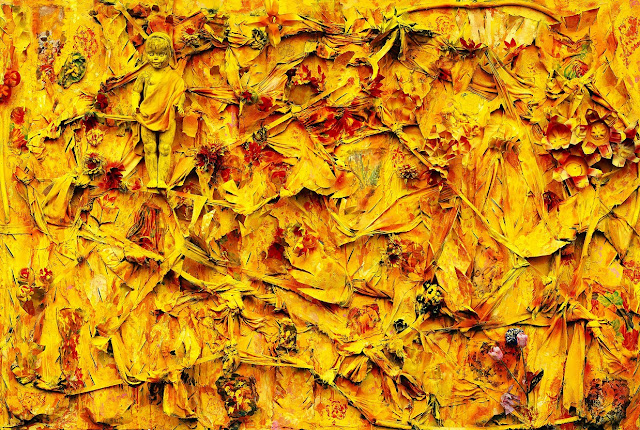"Thornton Dial, (born Sept. 10, 1928, Emelle, Ala.—died Jan. 25, 2016, McCalla, Ala.), American artist who created powerfully evocative assemblages, sculptures, collages, paintings, and drawings that reflected his personal history and events in the world. Dial had little formal schooling and did farm work as a child. When he was about 12 years old, he was sent to live with a relative in Bessemer, Ala., and he engaged in a variety of work, including carpentry and house painting, as a teen. He later became a metal worker at the Pullman Standard railroad-car manufacturing plant. Throughout his adult life he created assemblages, which he called “things,” out of found and discarded objects, possibly inspired by similar pieces made and displayed in rural front yards in parts of the South. In 1987 another folk artist, Lonnie Holley, introduced Dial to the collector William Arnett, who was on a mission to find and preserve vernacular African American art. In 1990 an exhibition of Dial’s work, “Thornton Dial: Ladies of the United States,” was mounted by Kennesaw State College (now Kennesaw State University) in Marietta, Ga. Numerous solo and group exhibitions followed, notably the traveling art show “Hard Truths: The Art of Thornton Dial,” which started at the Indianapolis Museum of Art in 2011 and concluded at the High Museum of Art in Atlanta in 2013. His notable works include the sculpture Lost Cows (2000–01), made from the bones of cattle, and Don’t Matter How Raggly the Flag, It Still Got to Tie Us Together (2003), in which bits of fabric were assembled to take on the appearance of a flag. Collections of Dial’s works were housed in such museums as the American Folk Art Museum and the Whitney Museum of American Art in New York City and the Hirshhorn Museum and Sculpture Garden and the Smithsonian American Art Museum in Washington, D.C."(britannica.com)
"In 2011, Dial's work was profiled in a four-page story in Time Magazine, where art and architecture critic Richard Lacayo argued that Dial's work belongs to the category of art and should not be pigeon-holed into narrowly defined categories:
"Dial's work has sometimes been described as "outsider art", a term that attempts to cover the product of everyone from naive painters like Grandma Moses to institutionalized lost souls like Martín Ramírez and full-bore obsessives like Henry Darger, the Chicago janitor who spent a lifetime secretly producing a private fantasia of little girls in peril. But if there's one lesson to take away from "Hard Truths: The Art of Thornton Dial," a triumphant new retrospective at the Indianapolis Museum of Art, it's that Dial, 82, doesn't belong within even the broad confines of that category....What he does can be discussed as art, just art, no surplus notions of outsiderness required....And not just that, but some of the most assured, delightful and powerful art around.
"Dial's work has sometimes been described as "outsider art", a term that attempts to cover the product of everyone from naive painters like Grandma Moses to institutionalized lost souls like Martín Ramírez and full-bore obsessives like Henry Darger, the Chicago janitor who spent a lifetime secretly producing a private fantasia of little girls in peril. But if there's one lesson to take away from "Hard Truths: The Art of Thornton Dial," a triumphant new retrospective at the Indianapolis Museum of Art, it's that Dial, 82, doesn't belong within even the broad confines of that category....What he does can be discussed as art, just art, no surplus notions of outsiderness required....And not just that, but some of the most assured, delightful and powerful art around.
Michael Kimmelman of the New York Times called Dial "preternaturally gifted," and said he looks "dumfoundingly adept to some of us because his energy and fluent line, abstracted in maelstroms of color, easily call to mind Pollock and de Kooning,"[10] while New York Times reporter Carol Kino described Dial's "work's look, ambition, and obvious intellectual reach hew[ing] closely to that of many other modern and contemporary masters, from Jackson Pollock and Robert Rauschenberg to Jean-Michel Basquiat."
In 1993, Dial's work was the subject of a large exhibition that was presented simultaneously at the New Museum of Contemporary Art and the American Folk Art Museum in New York. In 2000, the artist's work was included in the Whitney Biennial, and in 2005-06, the Museum of Fine Art; Houston presented a major exhibition entitled "Thornton Dial in the 21st Century". Dial's works can be found in many notable public and private collections, including those of, among other institutions, the High Museum of Art, the Museum of Fine Arts, Houston; the American Folk Art Museum, New York; the Philadelphia Museum of Art; The Hirshhorn Museum and Sculpture Garden, Washington D.C.; the Smithsonian American Art Museum, Washington D.C.; and the Indianapolis Museum of Art."Wikipedia
In 1993, Dial's work was the subject of a large exhibition that was presented simultaneously at the New Museum of Contemporary Art and the American Folk Art Museum in New York. In 2000, the artist's work was included in the Whitney Biennial, and in 2005-06, the Museum of Fine Art; Houston presented a major exhibition entitled "Thornton Dial in the 21st Century". Dial's works can be found in many notable public and private collections, including those of, among other institutions, the High Museum of Art, the Museum of Fine Arts, Houston; the American Folk Art Museum, New York; the Philadelphia Museum of Art; The Hirshhorn Museum and Sculpture Garden, Washington D.C.; the Smithsonian American Art Museum, Washington D.C.; and the Indianapolis Museum of Art."Wikipedia













No comments:
Post a Comment